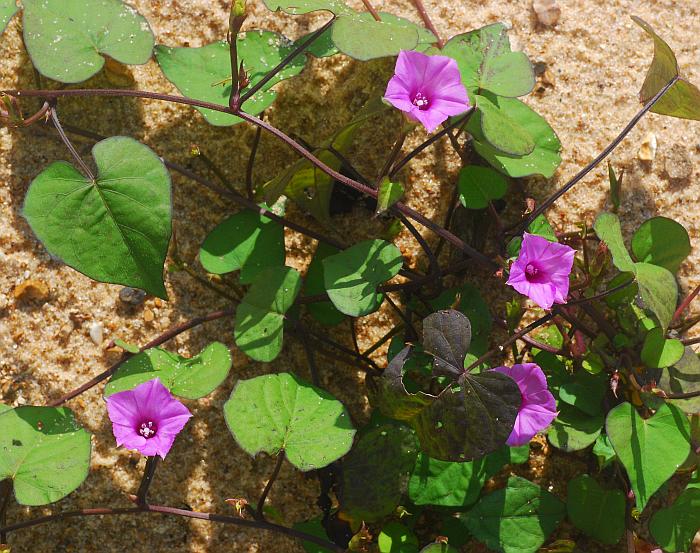Ipomoea xleucantha Jacq.
Small Pink Morning Glory

Native
CC = n/a
CW =
MOC = 0
© SRTurner
Ipomoea xleucantha Jacq.Small Pink Morning Glory | |
 |
Native CC = n/a CW = MOC = 0 |
© SRTurner |
|
Family - Convolvulaceae Habit - Annual hybrid forb. Stem - Prostrate, sprawling, or twining and climbing in other vegetation, usually sparsely to moderately pubescent.
Leaves - Alternate, simple, petiolate. Petioles hairy. Blades broadly ovate, deeply cordate at the base, the tips usually sharply pointed to acuminate, the margins entire or sometimes lobed, the upper surfaces glabrous or nearly so, the lower surfaces usually moderately hairy, especially along the venation.
Inflorescences - Axillary flowers, solitary or in small clusters of a few flowers, the stalks moderately to densely pubescent with relatively long, spreading to downward-angled hairs. Flowers subtended by a pair of small bracts.
Flowers - Sepals lanceolate to narrowly ovate, or narrowed or tapered to a sharply pointed tip, the margins sparsely to moderately pubescent with spreading hairs. Corollas funnelform to slightly bell-shaped, glabrous, the tube widened gradually toward the tip, pink to purple. Stamens 5, not exserted. Filaments white, to 1 cm long, mostly glabrous but with thick pubescence at the base. Anthers pinkish-purple, 1.3 mm long. Ovary superior, conic, green, usually 2-locular. Style white, glabrous, the stigma white, 2-lobed.
Fruits - Globose or slightly depressed-globose capsules. Flowering - August - September. Habitat - Streambanks, pond margins, gravel bars, fields, pastures, fencerows, ditches, railroads, roadsides, open disturbed areas. Origin - Native to U.S. Lookalikes - None when flowering. The plant resembles a pink- or purple-flowered form of I. lacunosa. Other info. - This attractive species is believed to be a hybrid between I. lacunosa and I. cordatotriloba. The latter species has not been documented from Missouri, so the hybrid appears to be both stable and fertile. It has been collected from a few scattered counties in Missouri, and is probably more common than collections indicate. Its distinctness from I. lacunosa has not been universally accepted. On the other hand some authorities have elevated it to the species level as I. leucantha, a name which seems curiously inappropriate, as the epithet leucantha means "white flower." It has also been named as a form (f. purpurata) of I. lacunosa. The plant is relatively easy to identify, with its twining habit, heart-shaped leaves, and pink-purple flowers. A favored habitat is sand and gravel bars of medium-sized rivers, where it can be quite common. Photographs taken along the Bourbeuse River in Franklin County, MO, 8-19-2011, and along the Katy Trail near Dutzow, Warren County, MO, 8-27-2021 (SRTurner). |